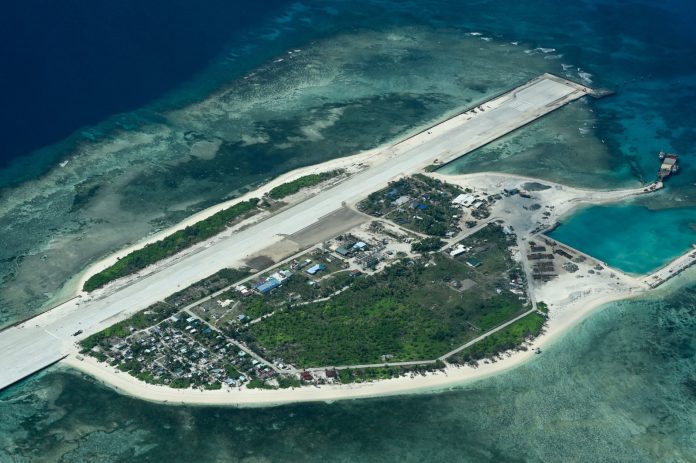Climate Change Commissioner Albert Dela Cruz and Coast Guard Commodore Jay Tarriela were incensed. Marine biologists had just shown them videos and data. Chinese trespassers had recently pulverized 12,000 hectares of corals in the West Philippine Sea.
Heavily damaged were Rozul (Iroquois) Reef and Escoda (Sabina) Shoal. No Filipino eyewitnesses witnessed the actual coral crushing. However, satellite images and signals pinpointed 48 Chinese fishing trawlers berthed there since September 2023.
Another indicator of Chinese environmental vandalism was the method used to grind the corals. It was very similar to how Chinese poachers in Panatag (Scarborough) Shoal replaced ship propellers with circular saws to dislodge endangered giant clams.
Rozul and Escoda are located on the southern side of Recto (Reed) Bank, fish-rich shallow waters off Palawan. Beijing covets the 5.4 billion barrels of oil and 55.1 trillion cubic feet of gas in Recto’s Sampaguita Field.
Southwestward is Ayungin (Second Tomas) Shoal where the Philippine Navy’s beached BRP Sierra Madre stands guard. To the northwest is Panganiban (Mischief) Reef, which Beijing seized in 1995 and transformed into an island fortress.
Locals avoided Recto after President Rody Duterte in June 2019 justified the ramming and sinking there of an anchored Filipino wooden boat by a Chinese steel trawler. The perpetrators abandoned 22 Filipinos thrown into the cold sea that midnight. Duterte dismissed the illegal hit-and-run as “an ordinary sea accident.”
The West Philippine Sea is the country’s 200-mile exclusive economic zone. It lies within the international South China Sea, which Beijing claims via a shifting nine- or ten-dash line.
“The destruction of coral is inestimable and irreparable,” Dela Cruz told Sapol-DWIZ: “Twelve thousand hectares is only the surface. Yet to be quantified are the meters-high sides and sand-embedded roots of these immobile animals, not to mention the fish that mate, spawn, and feed there.”
Reefs also contain minerals essential for high technology and substances for new medicines. They take centuries to form, and China’s destruction will take centuries more to restore naturally.
China’s motive remains unclear. It could be to thwart Philippine plans to secure Rozul, Escoda, and Recto. Perhaps to deter fishing by Filipinos in their own waters. Or merely outright hooliganism by the Chinese maritime militia, escorted by Chinese coastguards. Recto is 650 miles from China, well beyond its own EEZ.
China also degraded Sandy Cays 1, 2, 3, and 4 at the edge of the WPS. The newly formed islets are within the 12-mile territorial waters of Pag-asa, the main island of Palawan’s Kalayaan municipality.
Rubble and dead corals were piled up six feet high.
Intruders apparently rushed to form new protrusions on the sea surface. “I don’t know if you can find any island in the Philippines formed by nature, typhoon, or current that will grow that high [and that fast],” said University of the Philippines Biologist Prof. Jonathan Anticamara.
Former Supreme Court Justice Antonio Carpio theorized that China was building artificial islands to legitimize its concreting in 2013 of nearby Zamora (Subi) Reef into an airstrip. China misinterprets international law, thinking it can reduce Pag-asa’s 12-mile territorial waters via four artificial islets.
There’s a method to compute reef destruction. U.P. marine scientist Deo Florence Onda, PhD, proposed the use of Dutch researcher Elsevier’s method. That is, one hectare of reef produces $353,429, or P18 million worth per year.
That’s the same amount the Philippines loses per hectare per year due to China’s criminality. Manila can sue Beijing for damages.
The calculation: 12,000 hectares x P18 million = P216 billion a year, starting in 2024.
In 2020, international maritime lawyer Jay Batongbacal, PhD, reported 1,850 hectares of destruction since 2013 in Panatag, Panganiban, Zamora, and Kagitingan (Fiery Cross) Reef. Under Elsevier’s formula, former Foreign Secretary Albert Del Rosario (now deceased) calculated the damage over seven years at P231.7 billion.
China should also be made to pay that P231 billion.
Jarius Bondoc is an award-winning Filipino journalist and author based in Manila. He writes opinion pieces for The Philippine Star and Pilipino Star Ngayon and hosts a radio program on DWIZ 882 every Saturday. Catch Sapol radio show, Saturdays, 8 to 10 a.m., DWIZ (882-AM).
The views expressed in this article are the opinions of the author and do not necessarily reflect the editorial stance of LiCAS News.









